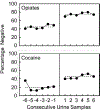Effects of time-based administration of abstinence reinforcement targeting opiate and cocaine use
- PMID: 32249414
- PMCID: PMC7387179
- DOI: 10.1002/jaba.702
Effects of time-based administration of abstinence reinforcement targeting opiate and cocaine use
Abstract
Polydrug use is a common problem among patients in opioid-substitution treatment. Polydrug use has been reduced by administering abstinence-reinforcement contingencies in a sequence, such that a single drug is targeted until abstinence is achieved, and then an additional drug is targeted. The present study examined effects of administering abstinence-reinforcement contingencies sequentially based on time rather than on achieved abstinence. Participants accessed paid work (about $10/hr maximum) in the Therapeutic Workplace by providing urine samples 3 times per week. The urine samples were tested for opiates and cocaine. During an induction period, participants earned maximum pay independent of drug abstinence. Then, maximum pay depended upon urine samples that were negative for opiates. Two weeks later, maximum pay depended upon urine samples that were negative for both opiates and cocaine. Opiate and cocaine abstinence increased following administration of the respective contingencies. The time-based administration of abstinence reinforcement increased opiate and cocaine abstinence.
Keywords: abstinence reinforcement; contingency management; drug addiction; incentives; therapeutic workplace.
© 2020 Society for the Experimental Analysis of Behavior.
Figures





Similar articles
-
Employment-based abstinence reinforcement promotes opiate and cocaine abstinence in out-of-treatment injection drug users.J Appl Behav Anal. 2014 Winter;47(4):681-93. doi: 10.1002/jaba.158. Epub 2014 Oct 8. J Appl Behav Anal. 2014. PMID: 25292399 Free PMC article. Clinical Trial.
-
The therapeutic workplace to promote treatment engagement and drug abstinence in out-of-treatment injection drug users: a randomized controlled trial.Prev Med. 2014 Nov;68:62-70. doi: 10.1016/j.ypmed.2014.02.021. Epub 2014 Mar 4. Prev Med. 2014. PMID: 24607365 Free PMC article. Clinical Trial.
-
The effects of extended-release injectable naltrexone and incentives for opiate abstinence in heroin-dependent adults in a model therapeutic workplace: A randomized trial.Drug Alcohol Depend. 2019 Apr 1;197:220-227. doi: 10.1016/j.drugalcdep.2018.12.026. Epub 2019 Feb 14. Drug Alcohol Depend. 2019. PMID: 30852374 Free PMC article. Clinical Trial.
-
Behavioral factors predicting response to employment-based reinforcement of cocaine abstinence in methadone patients.Transl Issues Psychol Sci. 2016 Jun;2(2):192-202. doi: 10.1037/tps0000056. Transl Issues Psychol Sci. 2016. PMID: 27777965 Free PMC article.
-
A comparison between low-magnitude voucher and buprenorphine medication contingencies in promoting abstinence from opioids and cocaine.Exp Clin Psychopharmacol. 2006 May;14(2):148-56. doi: 10.1037/1064-1297.14.2.148. Exp Clin Psychopharmacol. 2006. PMID: 16756418 Clinical Trial.
Cited by
-
Evolution of the substance use landscape: Implications for contingency management.J Appl Behav Anal. 2025 Jan;58(1):36-55. doi: 10.1002/jaba.2911. Epub 2024 Aug 28. J Appl Behav Anal. 2025. PMID: 39193870 Free PMC article. Review.
-
Abstinence-contingent wage supplements for adults experiencing homelessness and alcohol use disorder: A randomized clinical trial.Prev Med. 2023 Nov;176:107655. doi: 10.1016/j.ypmed.2023.107655. Epub 2023 Aug 3. Prev Med. 2023. PMID: 37541600 Free PMC article. Clinical Trial.
-
Factors associated with obtaining employment among opioid use disorder patients enrolled in a therapeutic workplace intervention.Drug Alcohol Depend. 2021 Sep 1;226:108907. doi: 10.1016/j.drugalcdep.2021.108907. Epub 2021 Jul 21. Drug Alcohol Depend. 2021. PMID: 34311206 Free PMC article. Clinical Trial.
-
Quality of life during a randomized trial of a therapeutic-workplace intervention for opioid use disorder: Web-based mobile assessments reveal effects of drug abstinence and access to paid work.Drug Alcohol Depend Rep. 2021 Dec 4;1:100011. doi: 10.1016/j.dadr.2021.100011. eCollection 2021 Dec. Drug Alcohol Depend Rep. 2021. PMID: 36843907 Free PMC article.
-
Employment outcomes of substance use disorder patients enrolled in a therapeutic workplace intervention for drug abstinence and employment.J Subst Abuse Treat. 2021 Jan;120:108160. doi: 10.1016/j.jsat.2020.108160. Epub 2020 Oct 6. J Subst Abuse Treat. 2021. PMID: 33298300 Free PMC article.
References
-
- Aklin WM, Wong CJ, Hampton J, Svikis DS, Stitzer ML, Bigelow GE, & Silverman K (2014). A therapeutic workplace for the long-term treatment of drug addiction and unemployment: Eight-year outcomes of a social business intervention. Journal of Substance Abuse Treatment, 47, 329–338. 10.1016/j.jsat.2014.06.013 - DOI - PMC - PubMed
-
- Bigelow GE & Silverman K (1999). Theoretical and empirical foundations of contingency management treatments for drug abuse In Higgins ST and Silverman K (Eds.), Motivating Behavior Change Among Illicit-Drug Abusers (pp. 3–31). Washington DC: American Psychological Association; 10.1037/10321-001 - DOI
-
- Bigelow GE, Stitzer ML, Griffiths RR, & Liebson IA (1981). Contingency management approaches to drug self-administration and drug abuse: Efficacy and limitations. Addictive Behaviors, 6, 241–252. https://doi.org/0306-4603(81)90022-8 - PubMed
-
- Center for Behavioral Health Statistics and Quality. (2018). 2017 National Survey on Drug Use and Health: Detailed Tables. Substance Abuse and Mental Health Services Administration, Rockville, MD: Retrieved from https://www.samhsa.gov/data/sites/default/files/cbhsq-reports/NSDUHDetai...
Publication types
MeSH terms
Substances
Grants and funding
LinkOut - more resources
Full Text Sources
Medical

